
Catholicism - Creative Heritage
This GCSE RE quiz on Catholicism takes a look at creative heritage. The Catholic Church has been a huge patron of the creative arts down the ages: we have a fine heritage of ecclesiastical buildings from Roman times, through the Renaissance and since, many of which have been fervently decorated with masterpieces of art and sculpture, and which have resonated with beautiful music from plainchant to the great polyphonic Masses and the sumptuous works of the Romantic composers. The Reformation produced its own, generally more modest, Protestant traditions in music and has tended to shun whatever might smack of ‘worldly extravagance’ in the decorative arts.
Catholicism and its tenets have meanwhile left their mark on other aspects of cultural life ~ such as through the Hays Code, which dominated moral standards in the US film industry between the heyday of Hollywood and the ‘swinging sixties’ period of Vietnam angst when ‘anything went’.
Ready for more?
not all...
quizzers. Try to win a coveted spot on our Hall of Fame Page.







